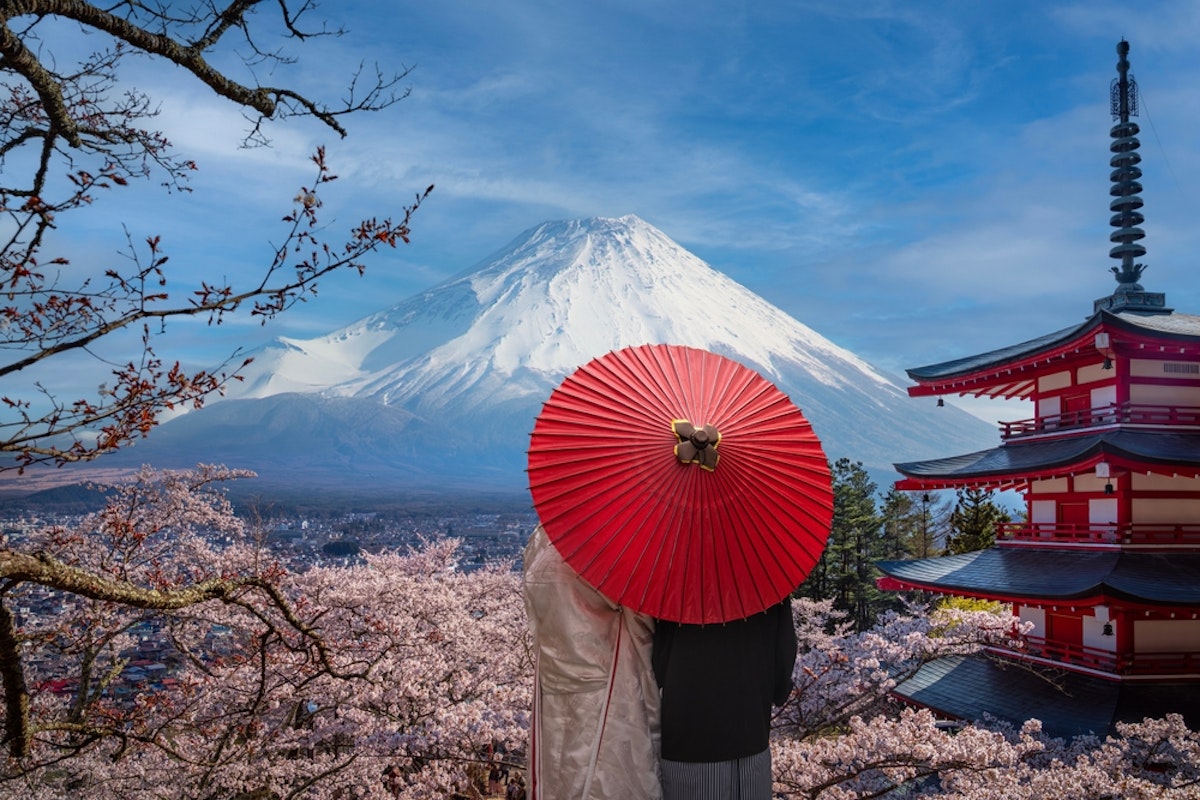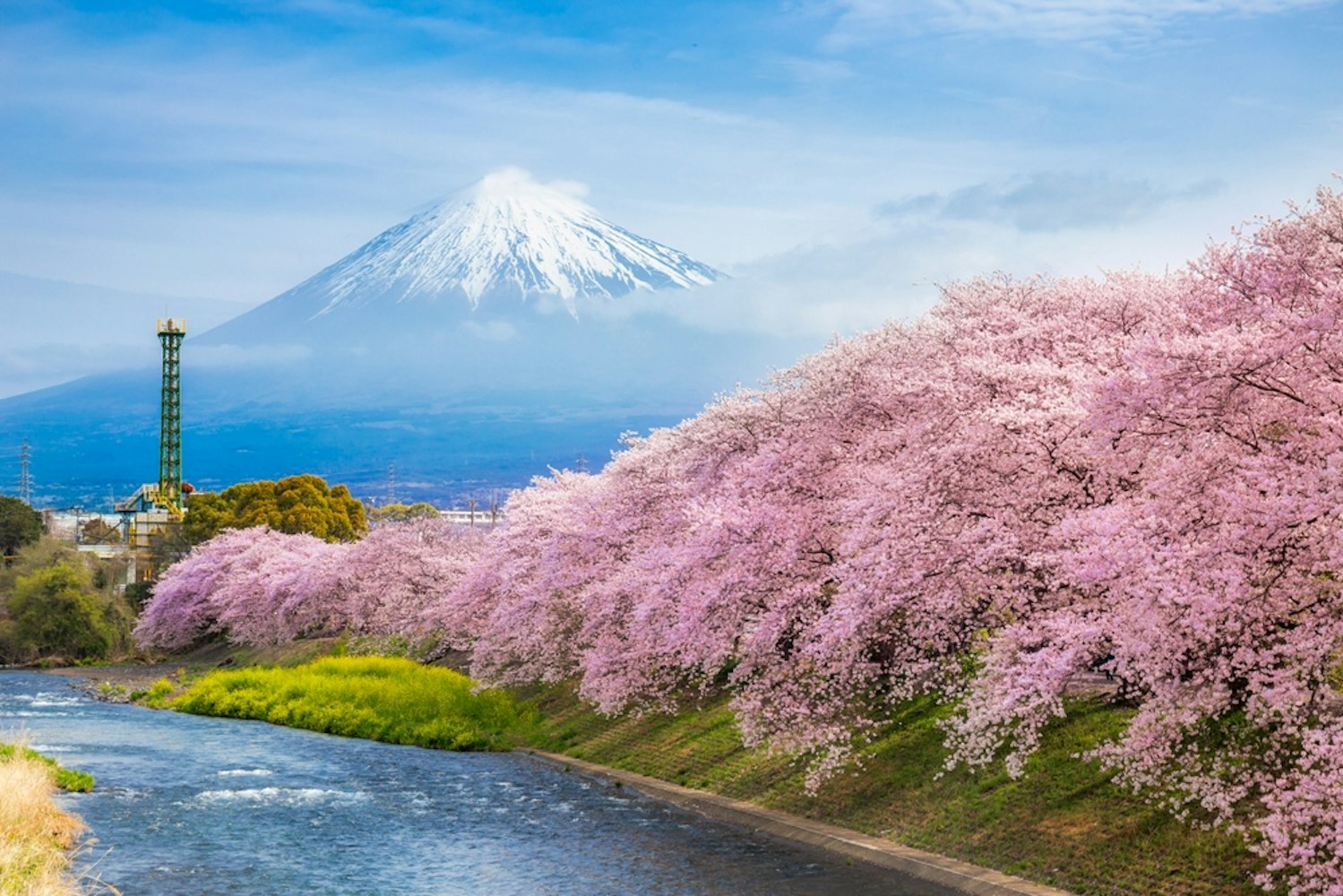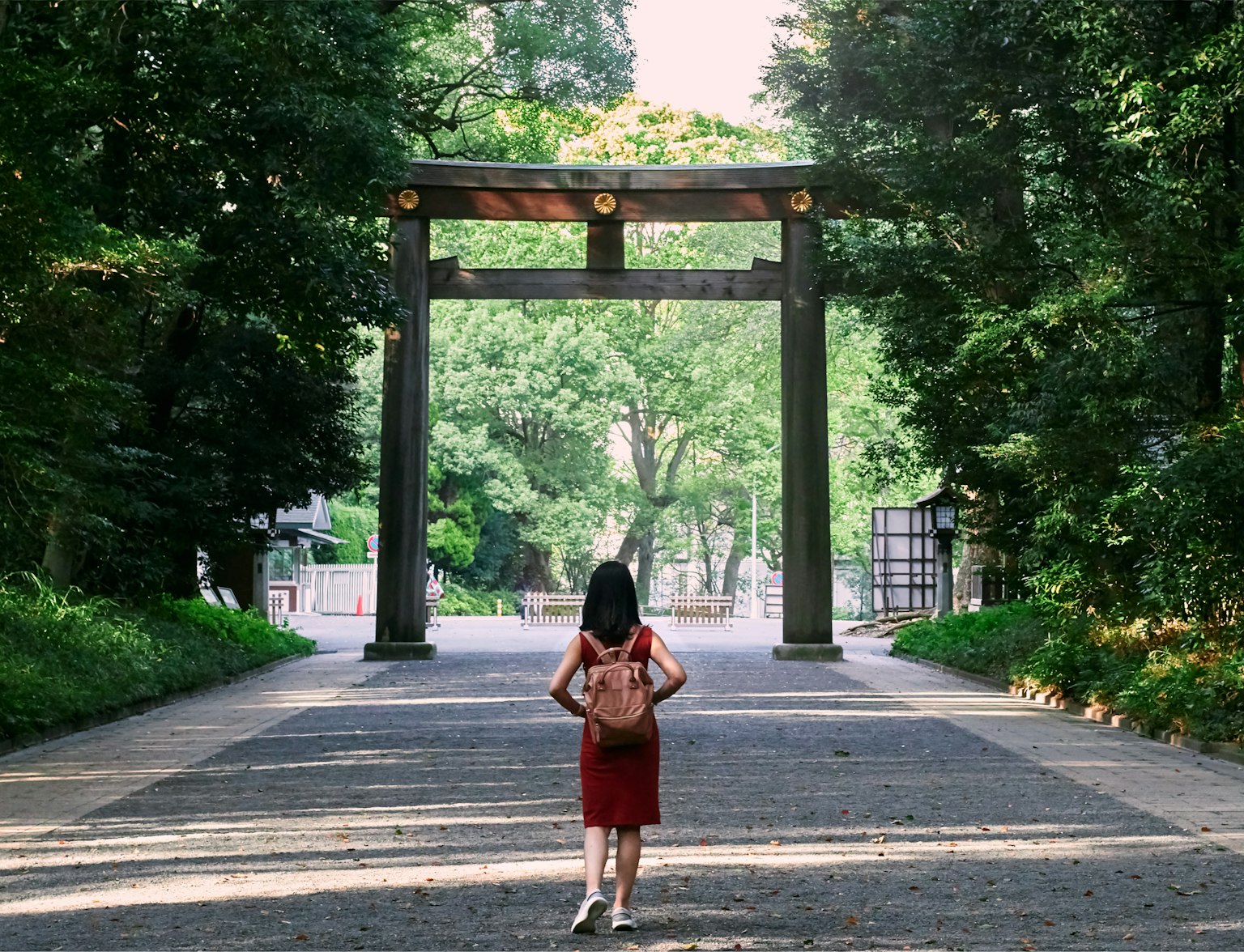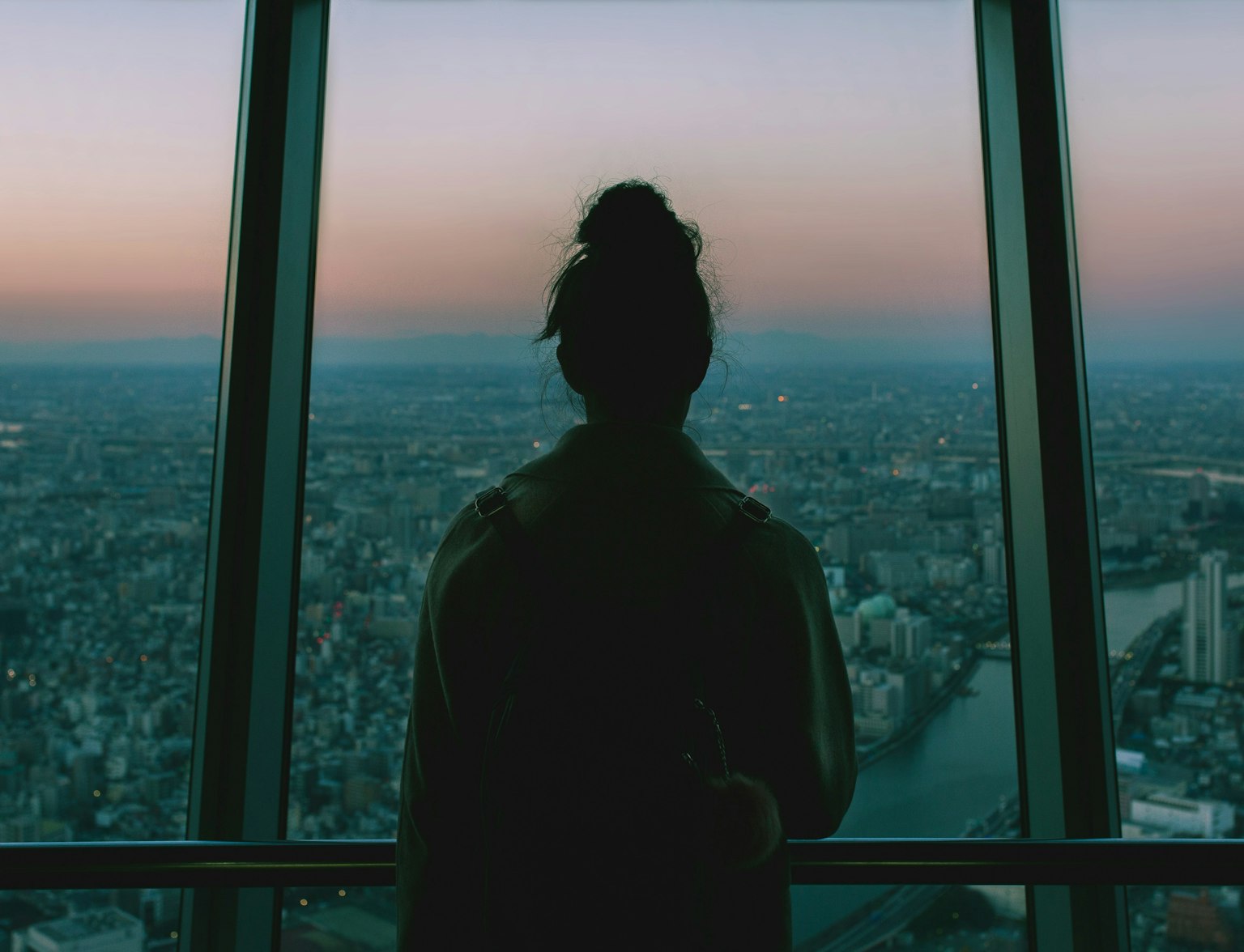

후지산은 일본에서 가장 잘 알려진 랜드마크 중 하나로, 수세기 동안 여행자, 예술가, 현지인을 사로잡은 놀라운 자연 봉우리입니다. 3,776미터(12,389피트) 높이로 우뚝 솟은 이 산은 일본에서 가장 높은 산으로, 맑은 날에는 도쿄에서 자주 볼 수 있습니다. 도쿄를 며칠 동안 방문하든 더 오래 머물든, 이 숨막히는 일본의 상징을 볼 수 있는 좋은 전망을 찾는 것은 보람 있는 경험이 될 수 있습니다.
이 가이드는 다음을 안내합니다. 도쿄 최고의 장소 후지산을 볼 수 있는 곳, 날씨와 계절이 중요한 이유, 그리고 가까이서 볼 수 있는 주변 명소를 볼 수 있습니다.

후지산을 둘러싼 예술, 문화, 영성을 개인 당일 투어로 경험하십시오.
그래도 후지산(富士山) 는 도쿄에서 남서쪽으로 약 100km(62마일) 떨어져 있으며, 그날의 날씨에 따라 위치를 알 수 있습니다. 날씨, 공기의 질, 계절이 모두 큰 역할을 합니다. 산은 공기가 훨씬 더 맑기 때문에 여름에 비해 겨울에 훨씬 더 자주 볼 수 있습니다. 따뜻한 계절에 도쿄의 습도와 안개는 하늘이 파랗게 보일지라도 시야를 가릴 수 있습니다.
하루 중 시간도 중요합니다. 이른 아침은 한낮의 열기로 인해 대기 중 안개가 발생하기 전에 산을 볼 수 있는 가장 좋은 기회를 제공합니다. 폭풍우가 지나간 늦은 오후에는 공기가 맑아져 후지산을 볼 수 있습니다.
도쿄에서 후지산을 감상하고 싶다면 할 수 있는 곳이 많이 있습니다. 각 지점은 고유한 관점을 제공하므로 몇 곳을 탐험하는 것은 노력할 가치가 있습니다.

신주쿠의 이 상징적인 마천루에는 45층에 위치한 노스 타워와 사우스 타워에 각각 하나씩 두 개의 무료 전망대가 있습니다.
남쪽 타워에서 바라보는 전망은 특히 안개가 적은 날에 후지산을 관찰하기에 특히 좋습니다. 건물의 중앙 위치로 인해 접근이 용이하며 무료 입장이 가능하여 여행자에게 매력적인 옵션입니다.
베스트 타임: 겨울철 이른 아침에 가장 선명한 시야를 제공합니다.

우리의 개인 투어를 통해 모든 영광의 활기찬 도시 도쿄를 발견하십시오.
일본에서 가장 높은 건축물인 도쿄 스카이트리는 도쿄에서 가장 높은 전망대 중 하나입니다. 지상 350m와 지상 450m에 있는 두 개의 데크는 맑은 날에는 후지산까지 뻗어 있는 탁 트인 전망을 제공합니다. 템보 갤러리아(Tembo Galleria)라고 불리는 더 높은 갑판은 산을 엿볼 수 있는 더 좋은 옵션입니다.

도쿄에서 경이로운 하루를 잠금 해제하세요!
롯폰기에 있는 이 54층 건물은 후지산의 전망을 즐길 수 있는 또 다른 환상적인 장소입니다. 실내에 위치한 도쿄 시티 뷰 전망대에서는 탁 트인 도시 경관을 감상할 수 있지만, 후지산을 가장 잘 보려면 스카이 데크로 가세요.
이 야외 옥상 공간은 산의 탁 트인 전망을 감상할 수 있으며, 특히 황금빛 빛이 산의 아름다움을 돋보이게 하는 일몰 동안에는 더욱 그렇습니다.

롯폰기 힐스 모리 타워(Roppongi Hills Mori Tower)에서 탁 트인 풍경을 감상하세요.
자연을 좋아한다면 도쿄 중심부 바로 외곽에 위치한 다카오산이 좋은 곳입니다. 정상까지 조금만 하이킹하면 후지산을 즐길 수 있는 평화로운 환경을 즐길 수 있습니다.
특히 맑은 날에는 녹지로 둘러싸인 산과 함께 경치가 아름답습니다. 가을 단풍이나 벚꽃 시즌에 방문하면 경험에 특별한 감동을 더할 수 있습니다.

도쿄의 상징적 인 랜드 마크를 맞춤형 하루 종일 개인 차량 투어로 경험하십시오.
하네다 공항은 비행기를 타기 위한 곳일 뿐만 아니라 후지산을 볼 수 있는 놀라운 장소이기도 합니다. 국내선 터미널과 국제선 터미널 모두 일반인에게 개방된 전망대가 있어 후지산을 배경으로 도쿄만 지역을 바라보며 휴식을 취할 수 있습니다.

도쿄에서 하네다 공항 (Haneda Airport)까지 고급 밴에서 번거 로움없는 개인 교통편을 경험하십시오.
해안가 전망을 즐기는 사람들에게 오다이바 해변 공원은 후지산을 잘 볼 수 있는 편안한 환경을 제공합니다. 해질녘에 방문하면 물에 비친 산의 고요한 전망을 볼 수 있습니다.
레인보우 브릿지(Rainbow Bridge)나 팀랩 보더리스(teamLab Borderless) 디지털 아트 뮤지엄과 같은 오다이바의 다른 명소를 둘러보는 것도 좋습니다.

아사쿠사에서 오다이바까지 크루즈를 타고 도쿄의 숨겨진 보석을 발견하세요!
이 덜 알려진 장소는 조용하고 자유로운 관람 경험을 원하는 사람들에게 인기가 있습니다. 25층의 전망 라운지에서는 도시 경관을 한눈에 볼 수 있으며, 맑은 날에는 멀리 후지산을 볼 수 있습니다. 인기 있는 곳보다 덜 붐비기 때문에 좀 더 편안한 분위기를 원한다면 좋은 선택입니다.

개인 도보 투어에서 도쿄의 매혹적인 매력을 발견하십시오.
타마 강 유역, 특히 후타코타마가와 근처는 탁 트인 하늘과 도시 경관으로 둘러싸인 후지산을 볼 수 있는 평화로운 장소를 제공합니다. 강을 따라 산책이나 자전거를 타면 완벽한 경치를 기다리는 동안 즐거운 외출을 할 수 있습니다.

도쿄 오메에서 타마강 래프팅 투어로 모험 정신을 발휘하세요.
날씨 확인: 날씨 앱이나 웹사이트를 사용하여 후지산의 가시성 예보를 추적하세요. 겨울철, 특히 비가 내린 후의 날씨는 종종 최상의 조건을 가지고 있습니다.
하루 중 시간: 일반적으로 이른 아침은 맑은 하늘을 볼 수 있는 가장 좋은 시간입니다.
사진용 장비: 사진 촬영을 좋아한다면 줌 렌즈를 가져와 멀리서도 산의 디테일한 사진을 찍을 수 있습니다.
멀리서 후지산을 보는 것만으로는 충분하지 않다면 당일 여행을 떠나 더 가까이 다가가는 것을 고려해 보세요. 산을 가까이서 즐길 수 있는 인기 있는 여행지는 다음과 같습니다.
가와구치 호수는 아마도 후지산을 가까이서 볼 수 있는 가장 유명한 장소일 것입니다. 호수는 산의 표면을 반사하여 사진에서 특히 눈에 띄는 거울과 같은 효과를 만듭니다. 이 지역은 방문객을 위한 시설이 잘 갖추어져 있으며 카페, 온천 시설, 사진 촬영 장소가 많이 있습니다.

후지산과 가와구치 호수로 떠나는 숨막히는 여행을 떠나보세요.
온천과 경치 좋은 전망으로 유명한 하코네는 휴식과 숨막히는 광경이 조화를 이루고 있습니다. 이 하코네 로프웨이 그리고 아시코 호수는 특히 후지산의 훌륭한 전망을 제공하는 것으로 잘 알려져 있습니다. 많은 사람들이 이 지역을 온전히 즐기기 위해 이곳 방문과 전통 료칸에서의 숙박을 결합합니다.

후지산과 하코네의 멋진 풍경을 개인 투어로 둘러보세요.
아라쿠라야마 센겐 공원에 있는 이 장소는 사진작가의 꿈입니다. 후지산을 배경으로 한 5층짜리 탑은 전 세계적으로 상징적인 장면이 되었습니다. 봄에는 벚꽃이, 가을에는 생생한 단풍이 풍경에 아름다움을 더합니다.

하루 종일 가이드 투어를 통해 일본의 숨막히는 풍경을 발견하십시오.
연중 시기는 도쿄에서 후지산을 얼마나 자주 볼 수 있는지에 중요한 역할을 합니다. 예상되는 사항은 다음과 같습니다.
겨울(12월-2월): 가장 맑은 하늘과 후지산을 볼 수 있는 가장 높은 기회. 눈 덮인 봉우리는 또 다른 매력을 더합니다.
봄 (3월-5월): 벚꽃이 피는 동안에는 가시성이 달라질 수 있습니다. 선선한 아침은 더 나은 기회를 제공하는 경향이 있습니다.
여름(6월-8월): 습도가 높고 잦은 비구름이 산을 가리는 경우가 많습니다. 이것은 정상까지 하이킹을 계획하는 사람들을 위한 등반 시즌입니다.
가을(9월-11월): 서늘한 날씨와 감소된 습도는 특히 후반기에 가시성을 향상시킵니다.
후지산은 자연의 아름다움 외에도 일본에서 문화적, 정신적, 역사적 중요성을 가지고 있습니다. 이곳은 수세기 동안 신성한 장소였으며 종종 신토 및 불교 관습과 관련이 있습니다. 호쿠사이(Hokusai)와 히로시게(Hiroshige)와 같은 예술가들은 우키요에 목판화로 그 형태를 불멸화했으며, 이는 일본 미술에서 가장 유명한 작품 중 하나로 남아 있습니다.
등산 후지산(富士山) 많은 사람들에게 영적 여행으로 간주되며 인내와 자연과의 연결을 상징합니다. 멀리서 바라보기만 해도 산의 존재는 평온함과 경외감을 불러일으킵니다.
도쿄에서 매일 후지산을 볼 수 있습니까?
가시성은 날씨와 공기 질에 따라 다릅니다. 특히 겨울에는 맑은 날이 도쿄에서 후지산을 볼 수 있는 가장 좋은 기회입니다. 여름에는 안개가 자주 끼어 산을 찾기가 더 어렵습니다.
도쿄에서 후지산을 볼 수 있는 가장 좋은 시기는 언제인가요?
겨울철(12월에서 2월)은 습도가 낮고 안개가 적기 때문에 가장 선명한 시야를 제공합니다. 폭풍우가 지나간 후 이른 아침과 늦은 오후에도 시야가 좋아집니다.
도쿄에서 후지산을 보기에 가장 좋은 전망대는 어디인가요?
인기 있는 전망대로는 도쿄 도청사, 도쿄 스카이트리, 롯폰기 힐스 모리 타워가 있습니다. 각 객실은 독특한 전망을 제공하며, 날씨가 좋은 날에는 산의 탁 트인 전망을 제공합니다.
도쿄에서 밤에 후지산을 볼 수 있습니까?
후지산은 일반적으로 밤에는 조명이 없기 때문에 볼 수 없습니다. 그러나 산의 실루엣은 보름달이 뜬 밤이나 눈이 정상을 덮고 빛을 반사할 때 때때로 볼 수 있습니다.
도쿄 공항에서 후지산을 볼 수 있습니까?
네, 하네다 공항의 전망대에서는 맑은 날에 후지산의 멋진 전망을 감상할 수 있습니다. 나리타 공항은 더 멀고 산을 찾기에 적합하지 않습니다.



